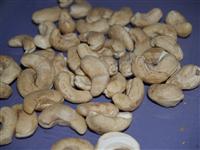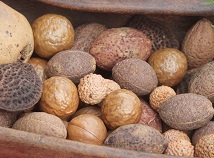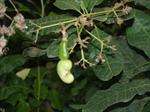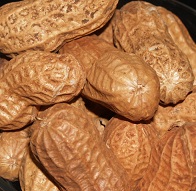Learn to grow nuts in tropical and sub-tropical climates
There are varieties looked at in this course you would never have known existed and there are cultural recommendations for some of the favourites. If you are planning to move to a tropical island and grow nuts, then look no further! If not, then you will be surprised at how much you will learn.

For most people, a nut is a type of food and a delightful food at that! Strictly speaking, not all nuts are edible; but this course is only concerned with edible nuts and in particular, the ones that are grown more extensively around the world in warm climates.
The tropical nut trees are dependent on your locality and conditions can vary quite considerably even in tropical areas, for example certain tropical areas may experience frosts. However there are so many varieties worth trying that it is worth learning about them all!
There are eight lessons including a special project in this course. This course is designed as a detailed look at identification and culture of nuts in warmer climates. Emphasis is placed on the species that are of horticultural value.
COURSE CONTENT
The course consists of eight lessons as follows:
1. Introduction
Review of the system of plant identification, main groups of nuts, information contacts (i.e. nurseries, seed, clubs etc.)
2. Culture
Planting, staking, mulching, watering, pest & disease, feeding, pruning, protection from wind, salt air etc.
3. Propagation
This lesson looks at the methods of propagating this group of plants. There is information on propagation in general and on specific species.
4. The Macadamia- A species from Australia that has become popular for production in Australia, South Africa and Hawaii.
5. The Pecan
6. Other Varieties which Grow in Warm Climates, such as an overview of number of old species you never would have thought of.
7. Selecting a site and planting a plot. The most important aspect of cultivating nuts is the correct site for their cultural needs.
8. Growing, harvesting and using nuts. There are various methods used and we look at some of those.
COURSE AIMS
- This course is for the curious grower who wants to learn more about types of warm climate nuts.In the lessons you will identify different nut crop varieties
- Learn about the classification of nuts
Learn to access sources of organisations specific to nut production
Learn about the cultural requirements of tropical nuts, as most of the varieties we look at are for the tropics or warm climates.
- Discover the characteristics of soils. Understand plant nutrition,
plant health, watering techniques,environmental protection for your crops, and
pest and disease management
- Techniques for pruning and maintenance are reviewed.
- Learn how to successfully propagate nut trees; propagation from nut seeds and cuttings
grafting, layering,establishing rootstocks
- Macadamia nut trees are looked at in detail
- Pecan nut trees are looked at in detail.
- Other varieties of nuts such as Pistachio, Cashew
Almond, Brazil and other varieties you never knew existed, are looked at
- Establishment and horticultural management of tropical nut trees is looked at.
- Learn about site selection for successful cultivation, planting techniques and
factors affecting the selection of a site.
- Then when you have all these factors taken into consideration, the harvesting and storage of nuts is reviewed.
WHAT IS A NUT?
Botanists define a nut as follows: "A dry, indehiscent, one seeded fruit, somewhat similar to an achene, but the product of more than one carpel, and usually larger with a hard woody wall"
"A dry, indehiscent, one seeded fruit, somewhat similar to an achene, but the product of more than one carpel, and usually larger with a hard woody wall"
(Reference: A Dictionary of Biology by Abercrombie et al, published by Penguin).
If you do not quite understand this description:
Indehiscent simply means that the fruit does not break open readily and release the seed
(Note: Legumes such as wattles or peas in contrast are dehiscent fruits -they dry, and then drop seeds while the dry fruits are still attached to the plant).
An Achene is a simple, thin walled fruit and contains only one seed. A strawberry in fact is a large number of individual tiny achenes which cover a fleshy receptacle (Note. The fleshy receptacle is what we eat as a strawberry; while the fruits and seeds are tiny gritty bits covering the surface).
Many types of plants have nuts as fruits; some are grown commercially as edible food products, and others are not.
Nuts are produced by the following trees; Quercus (oaks), Pecan, Filbert, Hickory, Macadamia,
Hazelnut and others.
Commercial Growers and Home Gardeners may be less rigid in the way they define a nut. Generally nuts are edible fruits or parts of fruits which are hard, relatively dry (unlike fleshy fruits), and are able to be roasted for eating, or in many cases, may be eaten fresh.
In some cases, the roasting may destroy undesirable chemicals in the nut, or may enhance the flavour.
In the strict botanical sense, a peanut would not be a nut, because there can be more than one seed inside a fruit; however peanuts are perhaps the most widely grown commercial nut in the world.
Nuts above all have a distinct advantage over other fruits in their keeping quality. Being a dry product, they are less susceptible to spoilage, and will generally store well without any sophisticated or expensive storage treatments. This characteristic alone extends their marketing life, and can eliminate many problems associated with other types of crops.
(Note: They may need protection from pests though (eg. rodents and other vermin).
There are many nuts which are grown and eaten in one region, but not commonly heard of in other parts of the world. This is particularly the case in many tropical areas, where nuts which are eaten by local people may offer significant potential for future commercial cropping.
Duration: 100 Hours
Using Cashews
 Cashew are a soft, oily nut that makes a delicious, rich nut butter. Cashews also go great in a basil, or herb pesto, giving it a rich creamy taste.
Cashew are a soft, oily nut that makes a delicious, rich nut butter. Cashews also go great in a basil, or herb pesto, giving it a rich creamy taste.
Cashews are frequently used in raw and vegan cooking to create a “dairy” experience, such as in the filling of raw cheesecakes, and made into nut cheeses to use on top of pizza and similar.
Cashews make a great snack, raw, roasted, honey roasted or salted. They are also great in a trail mix, in muesli bar slices, and in chocolate.
Cashews make an appearance in Thai dishes, such as in meat and vegetable stir fries. They are also frequently used in Indian cuisine, either whole, or ground and used as a base for curry sauces. Cashews are also used as a thickener in water based soups and stews.
Korma recipe
1/4 cup cashew halves
3tbsp boiling water
3 cloves garlic
A small knob of fresh ginger (about 2cm), chopped
3Tbsp vegetable oil
1 onion, peeled and finely chopped
1tsp ground coriander
1tsp garam masala
1tsp ground cumin
1tsp ground turmeric
1tsp chilli powder
3 chicken breasts, chopped into 2cm cubes
2-3Tbs tomato paste
1C (250ml) chicken stock
1/2C (125ml) cream
1/2C (125ml) natural yoghurt
Put the cashews in a bowl with the boiling water and set aside.
Blend garlic and ginger in a food processor, or if you don’t have one, finely dice them.
Heat up the oil and lightly sautee onions until soft. Add in the garlic and ginger and spices and heat whilst stirring until fragrant (30-60 seconds).
Stir in the chicken pieces until lightly browned, then add in tomato paste and chicken stock. Simmer for 15-20mins, stirring occasionally.
While the chicken is simmering, in a food processor blend together the cashews and water, cream and yoghurt. Stir into the chicken and allow to simmer for another 15 – 20mins.
Serve with rice.
Salted Caramel Cashews
50g Butter
1/4C Water
3/4C sugar
1/2tsp salt
2C cashews
Put all ingredients except cashews in a saucepan and bring to the boil. Boil for 1 minute then add in the nuts. Coat completely, then turn the nuts onto a tray lined with baking paper. Spread the nuts out so they don’t all stick together. The caramel will harden as it cools. You can play around with adding more or less salt, according to your taste.
Raw cashew cheesecake
Crust ingredients
1 1/2C macadamia nuts (pre-soaked in water for 4 hours if possible then rinsed)
1/2C dates
1 pinch sea salt
In a food processor blend together all ingredients until it reaches a sticky but crumbly consistency. Press into your cheesecake tin.
Filling
3C cashews (pre-soaked in water for 4 hours if possible then rinsed)
3/4C lemon juice
3/4C agave or honey
3/4C coconut oil
1Tbsp vanilla extract
1/4 cup of water to help blend – only use as necessary
Put all ingredients into a food processor and blend thoroughly, using water to facilitate blending as required.
When smooth, pour into crust and place in a freezer. Keep in the freezer until firm (about 2 hours), then allow to defrost in the fridge or on countertop before serving.
You may like to top with berries or other fruit to serve.

WHAT NEXT?
Register to Study -Go to panel toward top of this page (right column)
or
Get Advice -Use our FREE COUNSELLING SERVICE to contact a tutor
CLICK TO CONTACT US